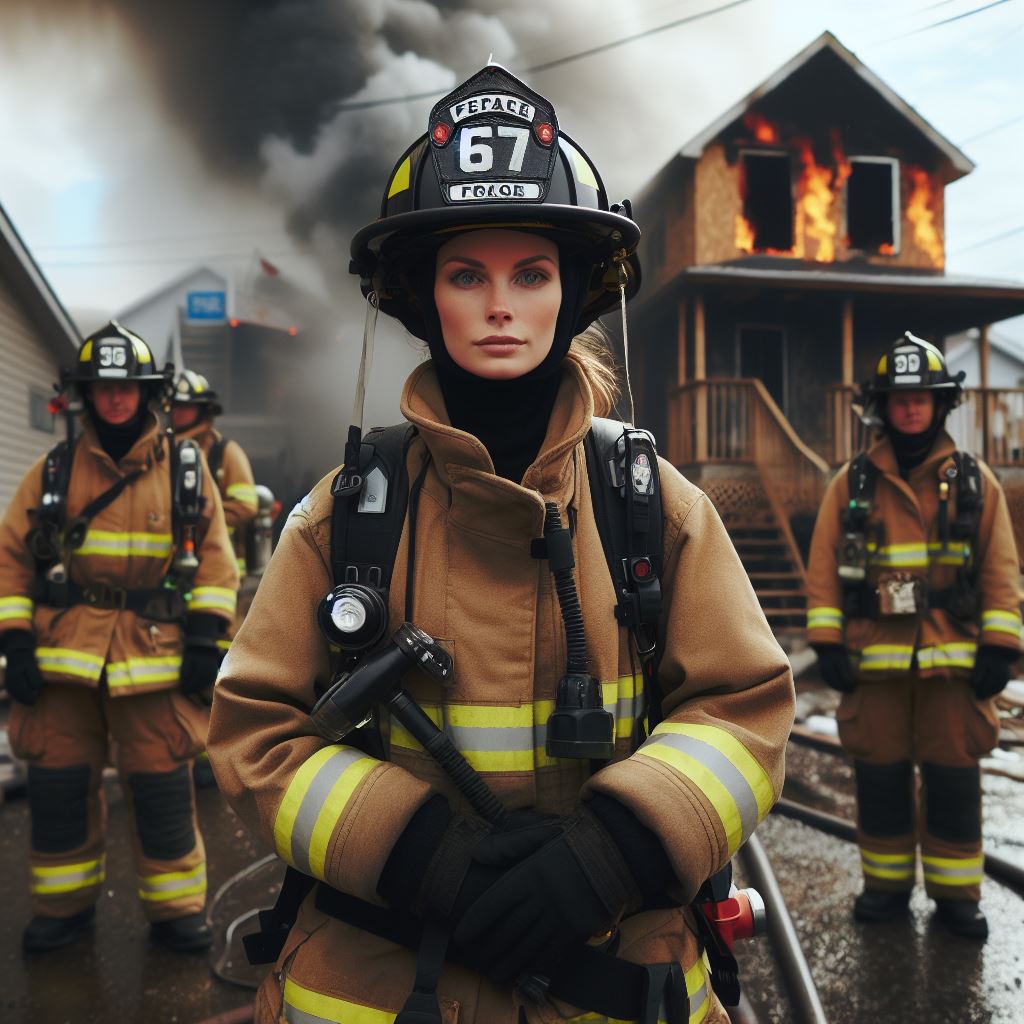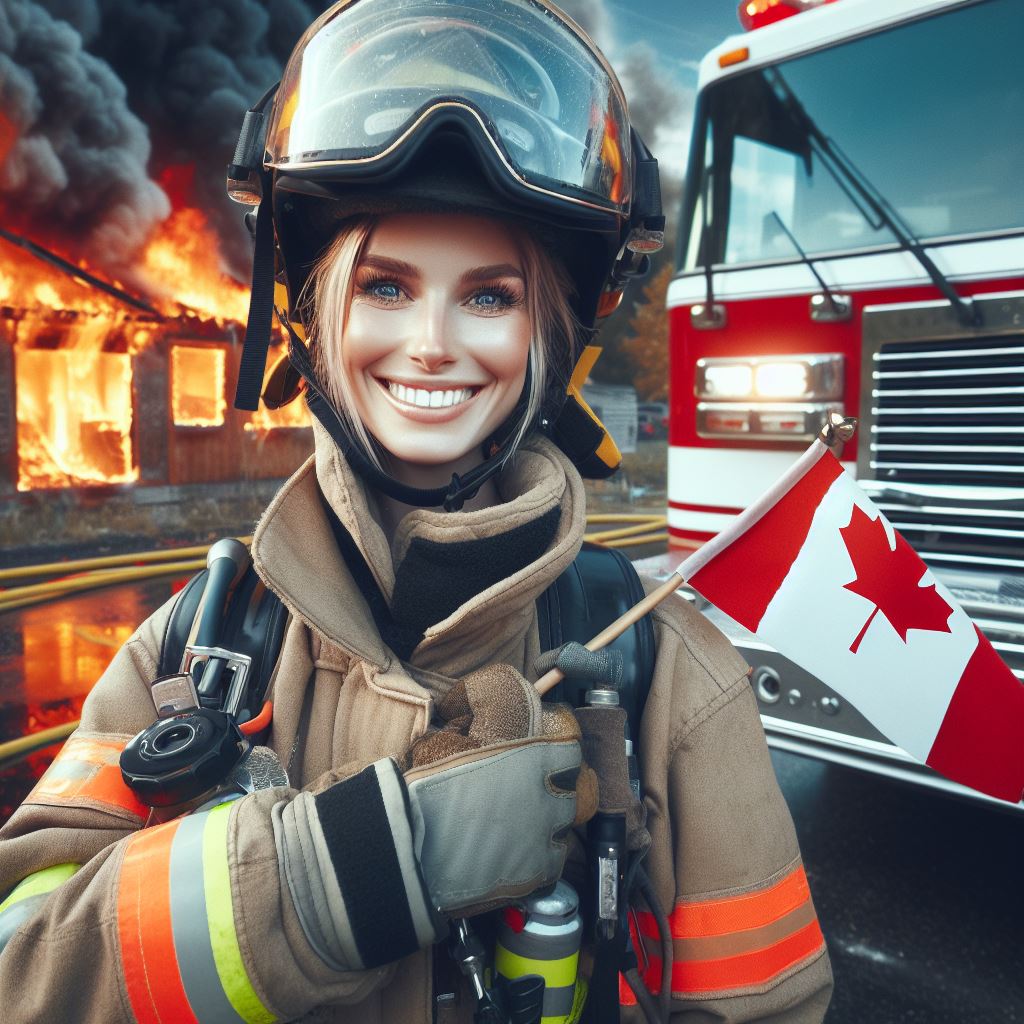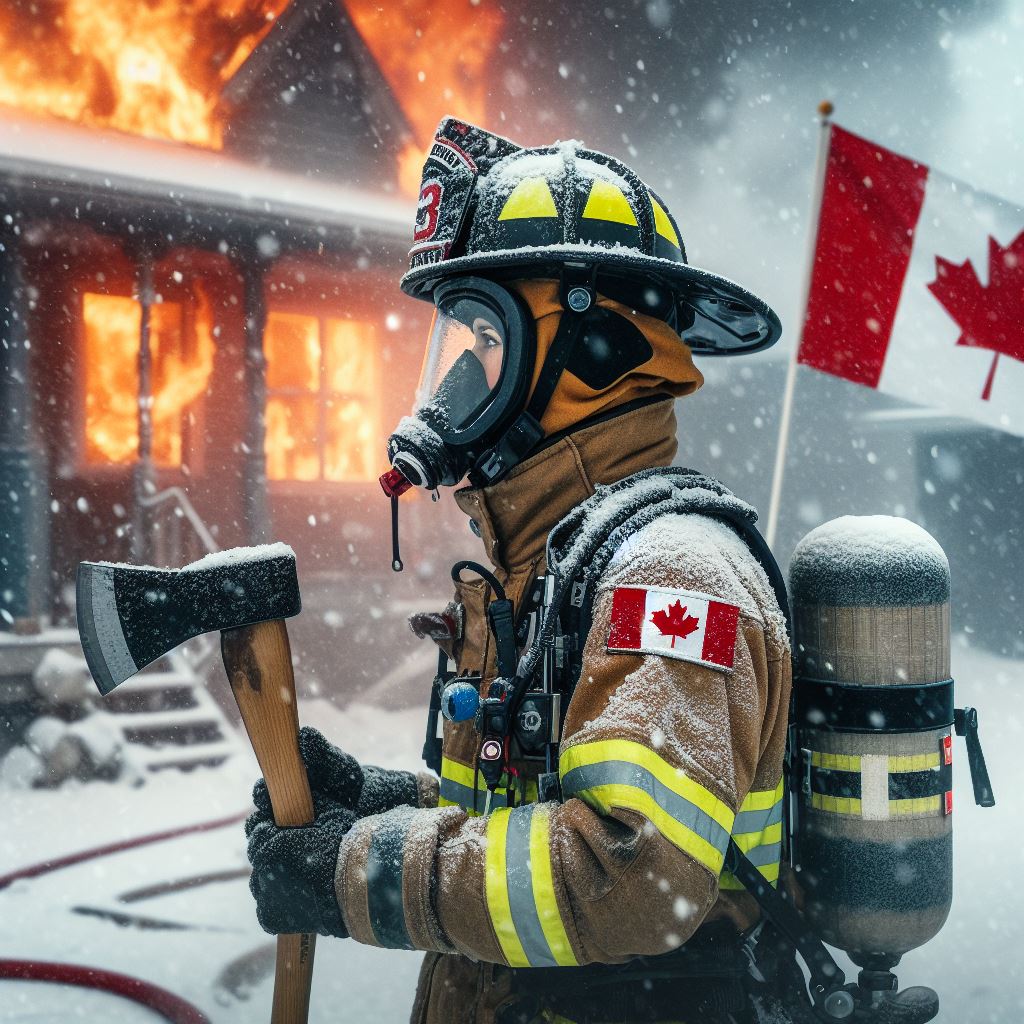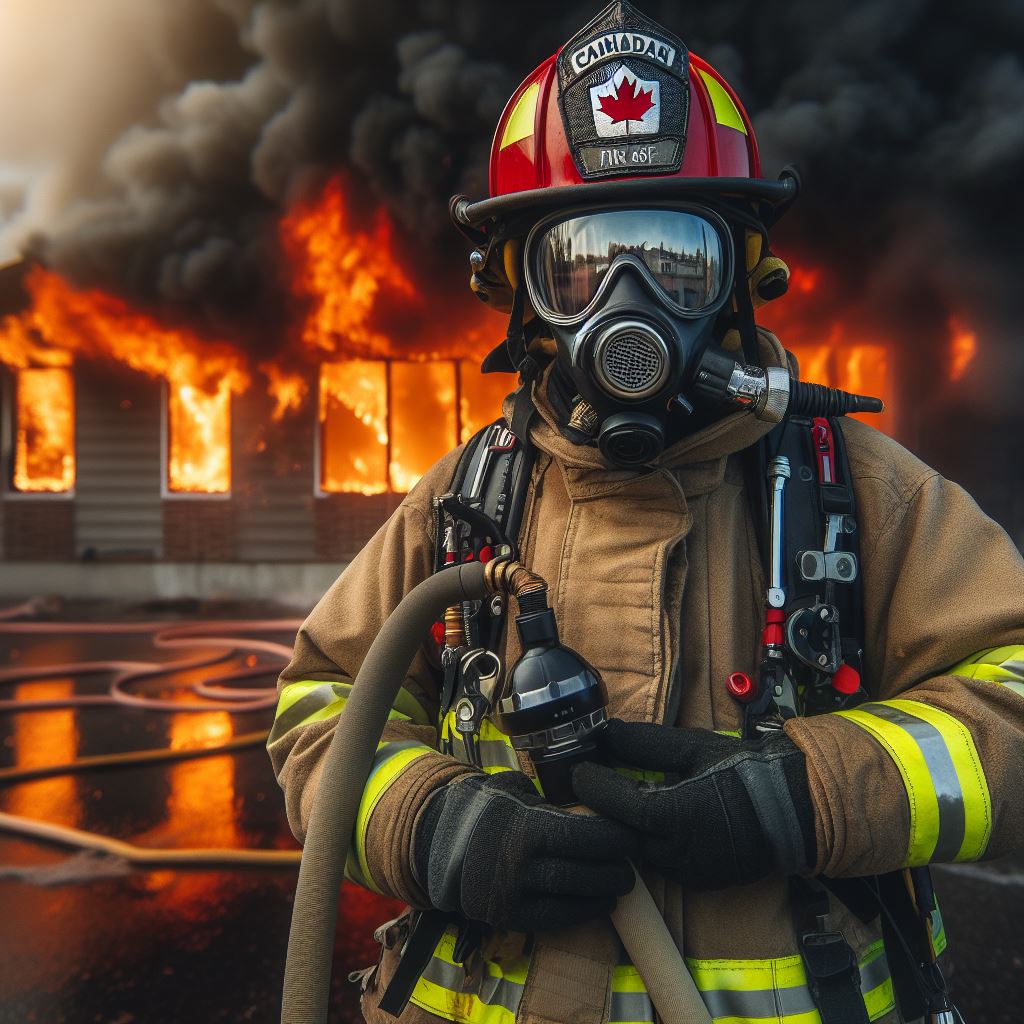Introduction
In Canada, firefighters play a vital role in ensuring public safety and protecting lives and property.
With a diverse range of emergencies, including wildfires, industrial accidents, and residential fires, their skills are in high demand.
As first responders, they mitigate immediate risks, conduct rescues, and provide vital community support.
Canada’s vast geographical expanse and varied climates amplify the need for a well-trained firefighting force.
Additionally, firefighters contribute to public safety through education and prevention efforts.
The demand for skilled firefighters remains constant, as they are indispensable in preserving the well-being of Canadian communities and ensuring a rapid and effective response to emergencies.
The demand for firefighters is high due to the constant need for emergency response services across the country.
This blog post aims to guide readers on the steps they need to take to become a firefighter in Canada.
Whether you have always dreamed of this rewarding career or have recently developed an interest in it, we will provide you with the necessary information and guidance to help you achieve your goal.
Overview of Firefighting in Canada
Fighting fires is an important and necessary profession in Canada. Here is an overview of firefighting in Canada:
Statistics on the Number of Firefighters in Canada
- There are approximately 85,000 firefighters in Canada.
- These firefighters work in various sectors, including municipalities, wildlands, and industrial areas.
- Every year, there are about 50,000 structural fires in Canada.
- These fires result in an average of 175 deaths and 1,300 injuries annually.
Different Types of Firefighting Roles
Firefighting roles in Canada can be categorized into several types:
- Municipal Firefighters: These firefighters work in urban areas and respond to structural fires, hazardous materials incidents, and medical emergencies.
- Wildland Firefighters: They specialize in fighting fires in rural and forested areas, protecting wildlife and homes from wildfires.
- Industrial Firefighters: These firefighters work in industrial settings, such as oil refineries and chemical plants, where the risk of fires and hazardous materials is high.
- Airport Firefighters: They are responsible for responding to aircraft emergencies, including fires and rescue operations.
- Specialized Teams: There are also specialized teams, such as hazardous materials response teams and technical rescue teams, which handle specific types of emergencies.
Job Responsibilities and Benefits of Being a Firefighter
Being a firefighter comes with a range of job responsibilities and benefits:
- Responding to emergency calls, including fires, medical emergencies, and hazardous materials incidents.
- Conducting search and rescue operations to save lives and protect property.
- Participating in ongoing training to stay updated on the latest firefighting techniques and safety protocols.
- Building strong relationships with the community and providing fire prevention education.
- Enjoying a sense of fulfillment and making a meaningful impact on people’s lives.
- Being part of a close-knit team that relies on trust, cooperation, and teamwork to save lives.
- Having the opportunity for career advancement and specialization in various firefighting roles.
- Benefiting from job stability and competitive salary packages.
- Access to comprehensive health and pension benefits to secure their future.
In essence, firefighting in Canada is a challenging yet rewarding profession that requires courage, dedication, and a commitment to serve and protect the community.
Whether working in municipalities, wildlands, or industrial settings, firefighters play a crucial role in saving lives and safeguarding property.
Education and Qualifications
When it comes to becoming a firefighter in Canada, there are certain education requirements that need to be met.
These requirements ensure that aspiring firefighters have the knowledge and skills necessary to carry out their duties effectively and safely.
- Minimum Education Requirements: To become a firefighter in Canada, a high school diploma or equivalent is typically required. This demonstrates a basic level of education and is a prerequisite for further training.
- Importance of Physical Fitness: Physical fitness is of paramount importance in the firefighting profession. Firefighters need to be in excellent physical condition to handle the demands of their job, which can include carrying heavy equipment, climbing ladders, and performing strenuous rescue operations.
- Clearance Certificate: In addition to physical fitness, aspiring firefighters must obtain a clearance certificate, also known as a criminal background check. This certificate ensures that individuals have a clean record and are of good character, as firefighters are entrusted with public safety and hold positions of trust within their communities.
- Additional Certifications: While not always mandatory, obtaining additional certifications can greatly enhance a firefighter’s skillset and employability. Certifications in First Aid and CPR, for example, are highly valued as they equip firefighters with life-saving techniques and the ability to provide immediate medical assistance in emergency situations.
Overall, the education and qualifications required to become a firefighter in Canada reflect the demanding nature of the profession.
Apart from a high school diploma, physical fitness and a clearance certificate are crucial.
Pursuing additional certifications such as First Aid and CPR can further distinguish aspiring firefighters and make them more competitive in the job market.
Gaining experience and skills
Gaining experience and skills are crucial steps in becoming a firefighter in Canada.
These experiences not only enhance your resume but also provide you with the necessary practical skills needed in the field.
Importance of Gaining Practical Experience
Volunteer firefighting or co-op programs offer aspiring firefighters the opportunity to gain valuable practical experience.
Participating in these programs allows you to work directly with experienced firefighters, getting hands-on training in various situations.
- Volunteer firefighting allows you to learn the basics of fire suppression, search and rescue, and first aid techniques.
- Co-op programs provide a structured environment where you can develop skills and knowledge specific to firefighting.
- Both options give you valuable exposure to real-life emergencies, helping you understand the challenges and responsibilities of the job.
These experiences not only give you an edge over other candidates during the application process but also help you determine if firefighting is the right career path for you.
Developing Strong Leadership and Teamwork Skills
Firefighting is a team-oriented profession that requires effective communication, collaboration, and leadership skills.
Unlock Your Career Potential
Visualize a clear path to success with our tailored Career Consulting service. Personalized insights in just 1-3 days.
Get StartedGaining experience in volunteer firefighting or co-op programs helps you develop these essential qualities.
- Working in a team environment allows you to understand the importance of cooperation and unity during emergency situations.
- You’ll learn how to communicate efficiently with team members, ensuring everyone understands their roles and responsibilities.
- Leadership skills are honed through the need to make quick decisions and take control of challenging situations.
Strong leadership and teamwork skills are highly valued in the firefighting community and are essential for career advancement within the field.
Acquiring Relevant Skills
Aside from firefighting techniques, acquiring additional relevant skills can make you a more well-rounded candidate in the competitive job market.
- Emergency medical training is invaluable for firefighters, as they often need to provide immediate medical assistance at the scene.
- Obtaining certifications in specialized areas such as hazardous materials (hazmat) allows you to handle dangerous substances safely and effectively.
- Knowledge and training in technical rescue operations, water rescue, or high-rise firefighting can set you apart from other candidates.
By acquiring these skills, you demonstrate a commitment to ongoing professional development and a dedication to enhancing your abilities as a firefighter.
Therefore, gaining experience and skills through volunteer firefighting or co-op programs is vital for anyone aiming to become a firefighter in Canada.
These opportunities offer hands-on training, allowing you to develop practical skills, teamwork abilities, and leadership qualities.
Additionally, acquiring relevant skills such as emergency medical training or hazmat expertise further strengthens your candidacy.
By investing time and effort into gaining experience and acquiring skills, you enhance your chances of pursuing a successful career in firefighting.
Applying to firefighting agencies
- Prepare a strong resume that highlights your relevant skills, certifications, and firefighting experience.
- Create a well-crafted cover letter that showcases your passion for firefighting and willingness to learn.
The importance of a well-crafted personal statement
- Focus on your dedication to public service, physical fitness, and ability to work under pressure.
- Highlight any volunteer work or community involvement that demonstrates your commitment to serving others.
Networking and attending job fairs or recruitment events
- Make connections with firefighters and industry professionals to gain insights and potential job opportunities.
- Attending job fairs or recruitment events allows you to meet recruiters face-to-face and make a memorable impression.
Building relationships can help you get noticed and increase your chances of being hired.
Remember, firefighting agencies value physical fitness, teamwork, and leadership skills, so showcase these qualities in your application materials.
Stay informed about the specific requirements and qualifications of the firefighting agencies you are applying to.
Research their recruitment process and ensure you meet all the necessary prerequisites.
Once you have submitted your application, be patient and proactive in following up with the agency.
Continue to enhance your skills and knowledge through relevant courses and training programs.
Consider obtaining additional certifications such as first aid and CPR, hazardous materials training, or technical rescue training.
Volunteer with local fire departments or participate in a ride-along program to gain hands-on experience and demonstrate your dedication.
Prepare for the interview stage by practicing common firefighting interview questions and scenarios.
Dress professionally, maintain good eye contact, and demonstrate your enthusiasm for the firefighting profession.
Remember to adapt your application materials and approach based on the specific requirements of each fire agency.
With perseverance and a well-prepared application, you can increase your chances of becoming a firefighter in Canada.
Physical fitness and entrance tests
Firefighter applicants in Canada must meet specific fitness standards and pass physical tests to be eligible for the job.
The fitness standards and physical tests
Fire departments have established fitness standards that applicants must meet to ensure they can perform their duties effectively and safely.
- Applicants must meet minimum requirements for cardiovascular endurance, strength, and flexibility.
- Physical tests typically include tasks such as completing a timed run, carrying heavy equipment, and climbing stairs.
- These tests assess an applicant’s physical capabilities and ability to handle the physical demands of firefighting.
Tips for preparing for physical assessments
Preparing for physical assessments is crucial to increase the chances of success in becoming a firefighter.
- Start with a comprehensive physical training regimen that includes strength and endurance exercises.
- Focus on exercises that target the muscle groups used in firefighting, such as squats, lunges, and push-ups.
- Incorporate cardiovascular exercises like running, swimming, or cycling to improve overall endurance.
- Practice specific tasks required in physical tests, such as carrying weights or climbing stairs with gear.
- Seek guidance from fitness professionals or trainers experienced in firefighter fitness training.
Resources for exam preparation
In addition to physical fitness, written and practical exams are also integral parts of the firefighter application process.
Here are some resources that can help candidates prepare for these exams:
- Study guides and practice tests specific to firefighter exams are available online and in bookstores.
- Joining study groups or participating in mock exams can enhance preparation and simulate test conditions.
- Online forums and communities dedicated to firefighter recruitment often provide valuable tips and insights.
- Some fire departments offer preparatory workshops or courses to help candidates excel in the exams.
- Taking advantage of these resources can significantly improve the chances of passing the written and practical exams.
Remember, becoming a firefighter in Canada requires not only physical fitness but also preparation for the entrance tests.
By understanding the fitness standards, training appropriately, and utilizing available resources, aspiring firefighters can increase their chances of success in pursuing their dream career.
Read: Canadian Police Forces and Diversity
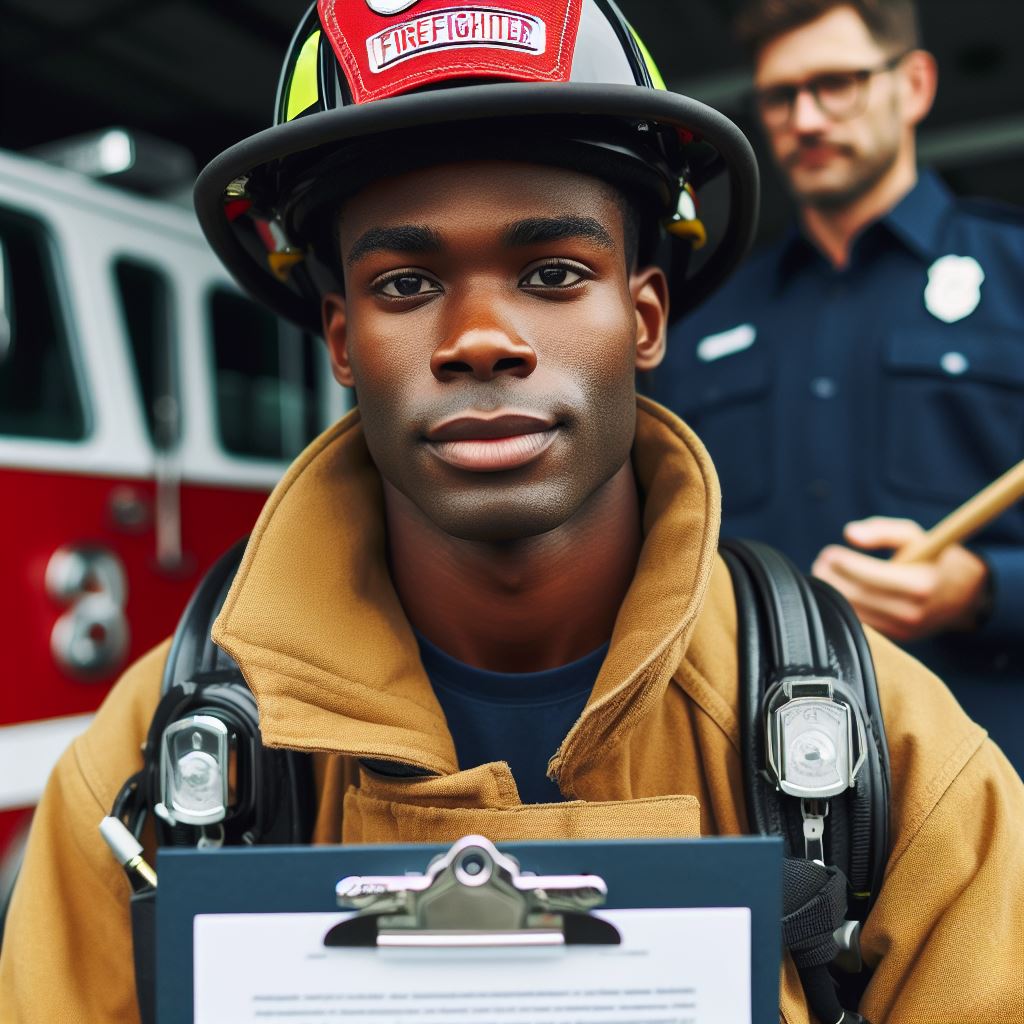
Interview Preparation and Tips
Preparing for a firefighter interview requires strategic planning and thorough preparation. Here are some tips to help you succeed:
The Common Interview Questions for Firefighter Positions
- Why do you want to become a firefighter?
- What do you know about our fire department?
- How do you handle high-pressure situations?
- Describe a time when you had to work as part of a team.
- How do you stay physically fit and maintain your mental well-being?
Advice on Preparing for Behavioral and Situational Questions
- Research and understand the key competencies required for a firefighter position.
- Prepare examples of situations in which you demonstrated these competencies.
- Use the STAR method (Situation, Task, Action, and Result) to structure your answers.
- Practice your responses with a friend or family member to receive feedback.
- Be prepared to adapt your answers to different situations or scenarios.
Suggested Strategies for Showcasing Relevant Skills and Experiences During the Interview:
- Review the job description and identify the skills and experiences they value most.
- Prepare specific examples that highlight these skills and experiences.
- Emphasize your ability to work in a team, adapt to challenges, and make quick, well-informed decisions.
- Showcase your knowledge of firefighting techniques, equipment, and safety protocols.
- Demonstrate your commitment to ongoing professional development and training.
During the interview, maintain a confident and professional demeanor. Remember to:
- Listen carefully to each question before providing a thoughtful and concise response.
- Use clear and confident language to communicate your ideas.
- Show enthusiasm and passion for the firefighting profession.
- Ask thoughtful questions about the department and the role you are applying for.
- Follow up with a thank-you email or letter to express your appreciation for the opportunity.
By thoroughly preparing for your firefighter interview, you can showcase your skills, experiences, and commitment to the profession. Best of luck!
Read: Day in the Life of a Canadian Firefighter
Training and Certification
Being a firefighter in Canada requires rigorous training and certification processes.
Successful applicants undergo a comprehensive training program that equips them with the necessary skills and knowledge to protect lives and property.
The training process for successful applicants
The training process for prospective firefighters begins with the application and selection phase.
Candidates must meet certain eligibility criteria, including age requirements, physical fitness standards, and educational qualifications.
Once selected, individuals embark on a structured training program conducted by recognized firefighting training institutions.
This program ensures that candidates acquire the fundamental skills and knowledge needed to handle various emergency situations.
The training typically consists of classroom lectures, practical exercises, and simulated scenarios.
Participants learn about fire behavior, hazardous materials, rescue techniques, first aid, and other essential aspects of firefighting.
They also receive training on operating firefighting equipment and vehicles.
Throughout the training process, candidates are evaluated through written exams, physical fitness tests, and practical assessments.
These assessments ensure that they meet the required standards before becoming certified firefighters.
The duration and content of firefighter training programs
The duration of firefighter training programs varies depending on the province or training institution. On average, these programs span several months to a year.
During the training, candidates undergo extensive theoretical instruction to develop a strong foundation of firefighting principles.
They learn about fire dynamics, building construction, fire prevention, and public safety protocols. This theoretical knowledge serves as the basis for practical training sessions.
Practical training is a crucial component of firefighter training programs. It includes hands-on exercises that simulate real-life emergency situations.
Candidates practice using firefighting equipment, performing search and rescue operations, extinguishing fires, and responding to hazardous materials incidents.
Additionally, candidates receive training in physical fitness and mental resilience, as firefighting requires strength and endurance.
They participate in physical training activities to improve their overall fitness levels and develop the stamina needed to perform firefighting duties effectively.
The importance of continuous learning and professional development opportunities
Once individuals become certified firefighters, their learning journey does not end.
Continuous learning and professional development opportunities are essential to stay updated with new firefighting techniques, equipment, and industry standards.
Firefighters are encouraged to participate in ongoing training programs, workshops, and seminars to enhance their skills and knowledge.
These opportunities enable them to keep up with advancements in firefighting technology, refine their techniques, and learn about new safety protocols.
Professional development also includes specialized training in areas such as hazardous materials handling, technical rescue operations, and incident command systems.
These additional certifications expand firefighters’ expertise and make them versatile in handling diverse emergency situations.
Moreover, firefighters can pursue higher education in fire science or related fields to gain a deeper understanding of the profession and advance their careers.
Continuous learning and professional development ensure that firefighters are well-prepared to protect communities and respond to ever-evolving challenges.
Generally, becoming a firefighter in Canada involves a comprehensive training process that prepares individuals for the demands of the profession.
The training programs cover both theoretical and practical aspects, emphasizing the importance of continuous learning and professional development to ensure high-quality service and safety in firefighting operations.
Read: Top Firefighting Schools Across Canada
Job opportunities and career progression
Sure! Here’s a blog section on “Job Opportunities and Career Progression in the Firefighting Profession in Canada”:
Overview of the various sectors where firefighters can work (municipal, government, airport, etc.)
Firefighting is an honorable and noble profession, dedicated to protecting life and property from fire hazards.
In Canada, there are various sectors where firefighters can work, providing diverse job opportunities in different settings. Let’s explore these sectors:
1. Municipal Fire Departments
- Municipal fire departments are the most common sector for firefighters in Canada.
- These departments serve cities, towns, and communities, responding to emergencies ranging from residential fires to hazardous material incidents.
- They are responsible for fire suppression, rescue operations, medical aid, and public education about fire safety.
2. Government Agencies
- Firefighters can also work for government agencies like provincial or territorial fire services.
- These agencies have jurisdiction over large areas and provide specialized emergency services, including wildfire suppression and search and rescue operations.
- They work closely with municipalities to ensure efficient coordination during major incidents.
3. Industrial and Airport Fire Services
- Industrial fire services employ firefighters to protect industrial facilities, such as oil refineries, chemical plants, and manufacturing plants.
- Airport fire services are responsible for fire suppression and rescue operations at airports, ensuring the safety of travelers and aviation infrastructure.
4. Military Fire Services
- Firefighters can also choose a career in the military, serving in the Canadian Armed Forces fire services.
- These specialized firefighters work on military bases and are responsible for protecting military personnel, equipment, and installations.
The potential for career advancement and specialization within the firefighting profession
Considering career advancement and specialization within the firefighting profession, there are several opportunities for growth:
1. Promotion to higher ranks
- Firefighters can also choose a career in the military, serving in the Canadian Armed Forces fire services.
- These specialized firefighters work on military bases and are responsible for protecting military personnel, equipment, and installations.
2. Specialization in various areas
- Firefighters can specialize in areas such as hazardous materials, technical rescue, wildland firefighting, or fire investigation.
- These specializations require additional training and knowledge, allowing firefighters to become experts in their chosen field.
The potential salary range for firefighters in Canada
Now, let’s discuss the potential salary range for firefighters in Canada:
1. Entry-level firefighters
Entry-level firefighters in Canada typically earn an annual salary ranging from $50,000 to $65,000, depending on the region and department.
2. Experienced firefighters and officers
Experienced firefighters and officers can earn salaries ranging from $70,000 to $100,000 per year, depending on their level of experience, rank, and location.
3. Additional benefits
Firefighters also receive benefits such as health insurance, pension plans, and paid time off, making their overall compensation package attractive.
In general, firefighters in Canada have various job opportunities within sectors like municipal, government, industrial, and military fire services.
With dedication and experience, firefighters can advance their careers through promotions and specialization.
Additionally, the profession offers a competitive salary range, making it an appealing choice for those interested in serving the community.
Read: Essential Gear for Firefighters in Canada
Conclusion
Becoming a firefighter in Canada requires dedication, physical fitness, and the completion of specific training programs.
We discussed the importance of obtaining a high school diploma and gaining relevant experience through volunteering.
Attending a firefighter training program, such as the National Fire Protection Association (NFPA) certification, is crucial.
We also highlighted the need for physical fitness, as firefighters face demanding physical challenges.
Furthermore, we emphasized the importance of maintaining a clean criminal record and passing medical examinations.
Overall, the path to becoming a firefighter in Canada is challenging but rewarding.
Don’t let the obstacles discourage you from pursuing your dreams of saving lives and serving your community.
If you’re interested in learning more about becoming a firefighter in Canada, check out the following resources:
- Canadian Firefighter
- Firefighters’ Association of Ontario
- National Fire Protection Association Canada
These organizations offer valuable guidance, training programs, and information to help you embark on your journey to become a firefighter in Canada.
Remember, with passion, determination, and the right resources, you can achieve your dream of becoming a firefighter in Canada.

